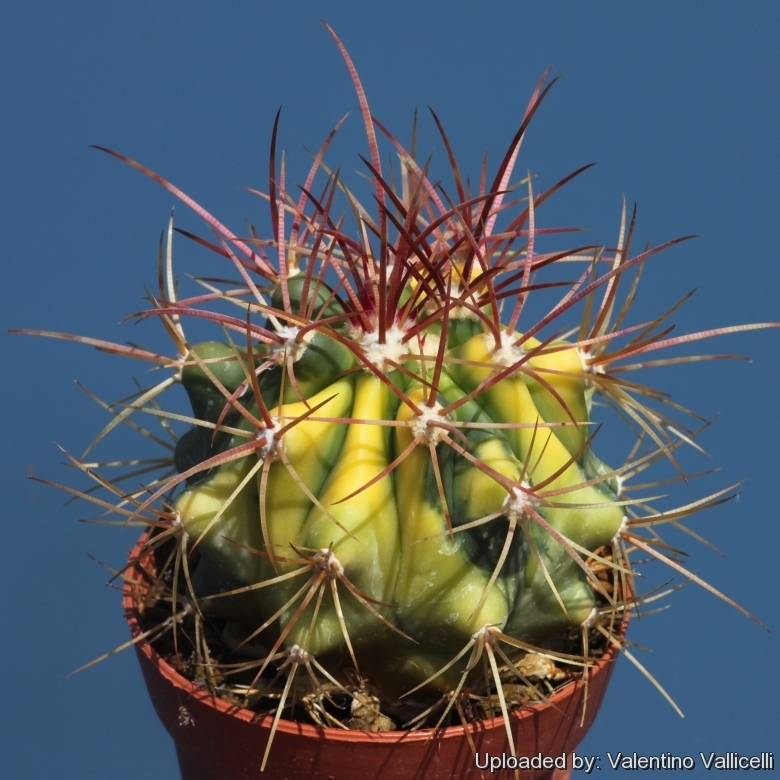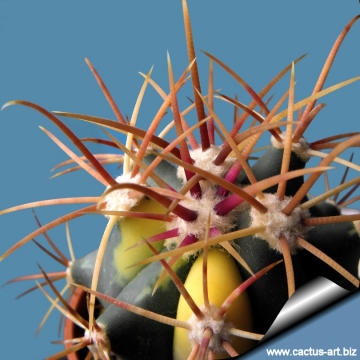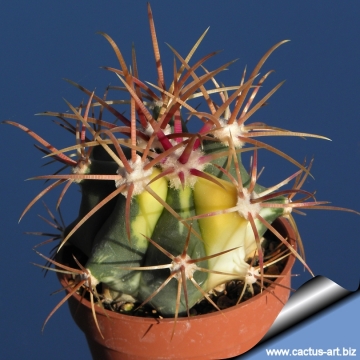Accepted Scientific Name: Ferocactus diguetii (F.A.C.Weber) Britton & Rose
Cactaceae (Britton & Rose) 3: 131. 1922 [12 Oct 1922] Britton & Rose

Ferocactus diguetii f. variegatus (Hybrid) Photo by: Valentino Vallicelli
Origin and Habitat: Garden origin (Nursery produced cultivar)
Synonyms:
See all synonyms of Ferocactus diguetii
back
Accepted name in llifle Database:Ferocactus diguetii (F.A.C.Weber) Britton & RoseCactaceae (Britton & Rose) 3: 131. 1922 [12 Oct 1922]Synonymy: 3
Accepted name in llifle Database:Ferocactus diguetii subs. carmenensis (G.E.Linds.) F.Wolf & R.WolfFerokakt. Baja California 93. 2004 [Jul 2004]Synonymy: 2
back
Description: Variegated Ferocacti are very rare in cultivation and some of these variegated plants are particularly priced by collectors. All variegates are mutants. Something has gone wrong with the cellular structure of the growth tip (apical meristem) of the plant. As a result of this mutation, chlorophyll is missing from some or all layers of the plant epidermis. The odd variegate appears in many seedling batches in a small percentage (especially among hybrid seeds) and are generally separated from normal plants. Variegated plants grow slower and are generally smaller than non-variegates of the same species. Coloured areas are also generally weaker, and more susceptible to fungus, sunburn and other defects. A large well grown variegate Ferocactus is truly an achievement. These are harder to grow well than they appear.
 Ferocactus diguetii f. variegatus (Hybrid) Photo by: Valentino Vallicelli
Ferocactus diguetii f. variegatus (Hybrid) Photo by: Valentino Vallicelli Ferocactus diguetii f. variegatus (Hybrid) Photo by: Cactus Art
Ferocactus diguetii f. variegatus (Hybrid) Photo by: Cactus Art Ferocactus diguetii f. variegatus (Hybrid) Photo by: Cactus Art
Ferocactus diguetii f. variegatus (Hybrid) Photo by: Cactus Art Ferocactus diguetii f. variegatus (Hybrid) Photo by: Cactus Art
Ferocactus diguetii f. variegatus (Hybrid) Photo by: Cactus ArtCultivation and Propagation: Variegated cacti are regarded as choice and difficult in cultivation, but despite that many of them are relatively easy to grow. But be aware that they cannot tolerate prolonged exposure to direct sun light (especially during the hottest summer days), so grow them in half-shade or under filtered sun. They are sometime seen as grafted plants, but some of this colourful plants (those with some chlorophyll) are able to grow on their own roots and are priced by collectors.
Soil: Use mineral well-permeable substratum with little organic matter (peat, humus).
Watering: Water sparingly from March till October, and keep perfectly dry in winter, at temperatures from 5 to 15 degrees centigrade. (In general these plants are more tender and cannot endure freezing temperatures). In the rest period no high atmospheric humidity!!
Propagation: By seeds, grafting or cutting. Because the variegation is due to the presence of two kinds of plant tissue, propagating the plant must be by a vegetative method of propagation that preserves both types of tissue in relation to each other. A most common way way to cultivate this partially de-coloured cultivars is to graft them onto another cactus which has chlorophyll and which will provide sugar to the mutant scion. The chlorophyll containing bottom part of the graft, called the stock, can be any number of different columnar cactus species.
Remarks: Seeds from variegated parents often give raise to some variegated seedlings too.














